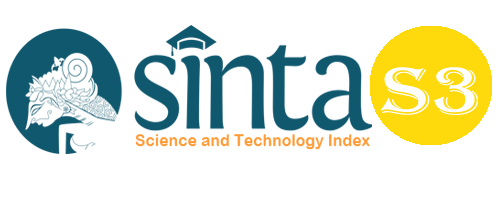Determining the Priority Strategy in the Implementation of E-Government Through SWOT Analysis Model
Abstract
Keywords
Full Text:
PDFReferences
Abdulla, Hedi Mustafa, and Karwan Hushyar Sherwani. 2017. “A Swot Analysis of Readiness for E-Government: As a Case of Kurdistan Regional Government.” International Journal of Social Sciences & Educational Studies 3(4): 66–72.
Andermo, Ani. 2014. “Revealing Georgia ’ s Tourism Potential.” Södertörn University School.
David, R. Fred. 2011. Strategic Management. New Jersey: Pearson Prentice Hall.
Desta, Kenenissa, and C. Cho Yoon. 2017. “Evaluating E-Government Implementation in Public Service Delivery.” Journal of Marketing Thought 4(1): 1–10.
Elsheikh, Yousef, and Mohammad Azzeh. 2017. “Prioritize E-Government Strategies Using SWOT-Ranked Voting Analysis Technique : The Case of Jordan.” IJCSNS International Journal of Computer Science and Network Security 17(1): 1–7.
Erwin, Loh, W. Long Paul, and Spurg Peter. 2019. Textbook of Medical Administration and Leadership. ed. Loh Erwin. Singapore: Springer Nature Singapore Pte.Ltd.
Ha, Huong. 2012. “A New SWOT Analysis of an E-Government System.” Integrated Information and Computing Systems for Natural, Spatial, and Social Sciences: 74–95.
Hussain, Abid, Ch Saghir, and Atif Khalil. 2016. “Strengths , Weaknesses , Opportunities and Threats : An Analysis of University of the Punjab.” Bulletin of Education and Research 38(2): 229–47.
Kahraman, Cengiz, Nihan Çetin Demirel, and Tufan Demirel. 2007. “Prioritization of E-Government Strategies Using a SWOT-AHP Analysis: The Case of Turkey.” European Journal of Information Systems 16(3): 284–98.
Kareem, Mohanad Ali, and Zeena Jabber Haseeni. 2015. “E-Government and Its Impact on Organizational Performance.” International Journal of Management and Commerce Innovations 3(1): 664–72.
Latif al Hakim. 2007. Global E-Government : Theory Aplications and Benchmarking. United States of America: Idea Group Publishing.
Mungai, Alfred Ngugi. 2017. “E-Government Strategy Implementation and Performance of the Public Sector in Kenya.” International Academic Journal of Human Resource and Business Administration 2(3): 301–38.
Pathak, Monika, and Gagandeep Kaur. 2014. “Impact of E-Governance on Public Sector Services.” International Journal of Emerging Research in Management &Technology 3(4): 100–103.
Pederson, Keld. 2016. “E-Government in Local Government: Challenges and Capabilities.” Electronic Journal of E-Government 14(1): 99–116.
Rezazadeh, F, N Hamidi, and Z Rezazadeh. 2011. “A SWOT and PEST Analysis of E-Government in Iran.” 5Thsastech.Khi.Ac.Ir: 1–9.
Rudi, and Abdul Prasetia Muis. 2018. “SWOT Analysis and Town Matrix E-Government on Tana Tidung City of Kalimantan Utara.” ELINVO(Electronics, Informatics, and Vocational Education) 3(May): 46–51.
Al Salmi, Muatasim Anwar Ahmed, and Norlena Bt Hasnan. 2015. “SWOT and TOWS Matrix E-Government Analysis Review on Sultanate of Oman.” International Journal of Learning & Development Vol. 5(No. 4): 13–23. http://dx.doi.org/ 10.5296 / i jld . v 5 i 4 . 8 64 1.
Tresna, Pratami Wulan. 2017. “External and Internal Environment Analysis ( A Study in Tasikmalaya City Embroidery Industry ).” Review of Integrative Business and Economics Research 6(1): 401–11.
Vena V, Raman. 2011. “E-Government in Malaysia: Barriers and Progress.” In Handbook of Research on Information Communication Technology Policy: Trends, Issues and Advancements, Hershey, Pennsylvania, USA: IGI Global, 1–792.
Visser, Wikus, and Hossana Twinomurinzi. 2008. “E-Government & Public Service Delivery : Enabling ICT to Put ‘ People First ’ – A Case Study from South Africa.” Systemics, Cybernetics and Informatics 6(6): 36–41.
Winarni, Liliek. 2018. “Development of Bureaucracy Based on Technology ( E-Government ) in the SWOT Perspective.” International Journal of Progressive Sciences and Technologies: 59–63
DOI: https://doi.org/10.33258/birci.v2i2.238
Article Metrics
Abstract view : 567 timesPDF - 325 times
Refbacks
- There are currently no refbacks.

This work is licensed under a Creative Commons Attribution-ShareAlike 4.0 International License.

This work is licensed under a Creative Commons Attribution-ShareAlike 4.0 International License.

_.gif)

















_.gif)



